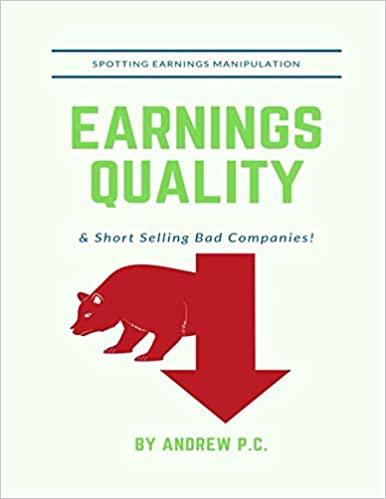Question
6. Institutional portfolios can take advantage of what is called portfolio margining under the rules of the CBOE and other options exchanges. What IS portfolio
6. Institutional portfolios can take advantage of what is called "portfolio margining" under the rules of the CBOE and other options exchanges. What IS portfolio margining? Choose only one answer.
A. You only pay attention to the bottom margin of the portfolio.
B. Great leverage is possible, as the intercorrelations and natural offsets (or what we call in English a "wash") are taken into consideration.
C. No margin is required, because these are not individual investors.
7. What does the symbol ^VVIX mean?
A. Apple's volatility.
B. An exchange-traded (ETF) volatility fund.
C. The implied volatility of the VIX options themselves.
8. An example of purchasing a "real" option is a company's opening of a Shanghai office, in order to have the capacity to pursue business in China.
True
False
9. A hedge fund is "short" a portfolio of VIX call options. It's "theta" is $16,788 per day. This means, barring some big market or political or terrorist event, the fund's net asset value will increase by about $16,788 per day.
True
False
10. Imagine an equity-oriented state pension fund (such as the State of Maryland Pension funds). Suppose their equity portfolio is NOT identical to the S&P 500 index. Further, suppose that due to a state budget shortfall, the year's additions to the pension fund are likely to be less than actuarially sound. Thus, the fund is becoming very risk-averse. And it needs to implement this feeling by hedging. CHOOSE THE BEST ANSWER, even though there might be more than one true answer. This is actually a question about hedge ratios. A. If the equity portfolio's beta is close to 0, then they could decide to match the overall exposure, via S&P Index futures contracts, to the fund's value. That is, # of contracts times the contract multiplier times the index would approximately equal the value of the fund.
B. If the equity portfolio's beta is close to .4, then they would have a tough time using S&P 500 contracts, so they would instead use foreign exchange contracts.
C. If the equity portfolio's beta is close to 1, then they could decide to match the overall exposure, via S&P Index futures contracts, to the fund's value. That is, # of contracts times the contract multiplier times the index would approximately equal the value of the fund.
11. Go to CMEGROUP.COM We are going to hedge ULSD https://en.wikipedia.org/wiki/Ultra-low-sulfur_diesel for a railroad, that uses ultra-light diesel fuel. Choose June 2017 as the underlying future. Let's pretend we are buying ten futures contracts. What would ten contracts cost you, using the last trade as our price? Show your math, i.e., #gallons times price per futures contract. Is this contract in contango, or normal backwardation?
12. Long options positions(long does not mean long-dated) have positive gamma, and short positions have negative gamma.
True
False
13. In valuing credit default swaps, one must estimate default probabilities. A start would be to obtain historical data for default rates from rating agencies such as Standard & Poor's. But a more complete risk profile, or risk prediction, limiting ourselves to the US market (US-based companies) would be to [pick only one choice, the best one, in your opinion]:
A. Also consider the risk of another earthquake in Japan.
B. Also consider the systematic risk associated with an economic downturn in the US, accompanied by a downturn in US stocks.
C. Also consider the possibility that Facebook options are trading at an implied volatility that is not as high as it should be, considering the lofty level of its P/E ratio.
14. A total return swap can be a form of financing vehicle to allow an investor to buy a specific bond, because: (there are two correct answers, you must pick two)
A. The payer (a financial institution) could agree to pay the bond's capital appreciation or depreciation, plus the interest payments, in return for receiving LIBOR plus some basis points.
B. The payer (a financial institution) could agree to receive the bond's capital appreciation or depreciation, plus the interest payments, in return for receiving LIBOR plus some basis points.
C. The payer retains ownership of the bond for the life of the contract.
Step by Step Solution
There are 3 Steps involved in it
Step: 1

Get Instant Access to Expert-Tailored Solutions
See step-by-step solutions with expert insights and AI powered tools for academic success
Step: 2

Step: 3

Ace Your Homework with AI
Get the answers you need in no time with our AI-driven, step-by-step assistance
Get Started


